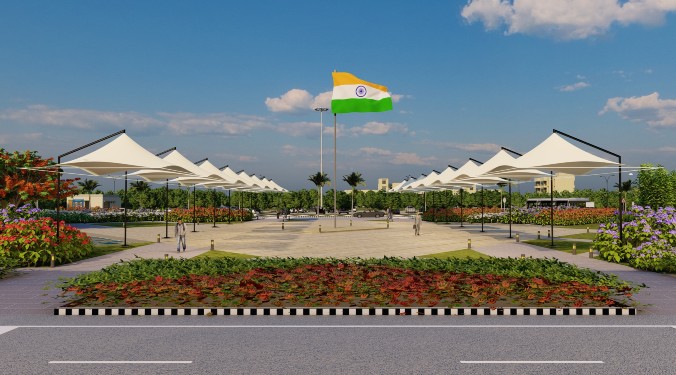“With the economy expected to grow 8-9 per cent per annum, we expect our growth to be in the range of 25-30 per cent which will be double the growth to Indian tile market,” says Santosh Nema, Chief Executive Officer, RAK Ceramics India
The Indian ceramic industry ranks at 8th position in the world and produces around 2.5 per cent of global output. RAK Ceramics, one of the leading global companies, is striving to be best in India within the next 4 years. In an exclusive interview with ACE Update, Santosh Nema shares why India is important in RAK’s global strategy.
What are the trends and opportunities in Indian ceramic industry? The ceramics industry in India came into existence about a century ago and has matured over time to form an industrial base. From traditional pottery making, the industry has evolved to find its place in the market for sophisticated insulators, electronic and electrical items. Over the years, the industry has been modernising through new innovations in product profile, quality and design to emerge as a modern, world-class industry, ready to take on global competition.
The Indian ceramic industry ranks at 8th position in the world and produces around 2.5 per cent of global output. The industry provides employment to 550,000 people, of whom 50,000 are directly employed. Gujarat accounts for around 70 per cent of total ceramic production.
The ceramic products are produced both in organised as well as in unorganised sector. The share of organised sector in total production is around 55 per cent. The organised sector is characterised by the existence of a few large players. While, small and medium enterprises (SMEs) account for more than 50 per cent of the total market in India, offering a wide range of articles including crockery, art ware, sanitary ware, ceramic tiles, refractory and stoneware pipes, among others. Most of the players are grouped together in clusters.
Over the last two decades, the technical ceramics segment has recorded an impressive growth propelled by the demand for high-alumina ceramics, cuttings tools and structural ceramics from the industry. Overall, the Indian ceramics industry has emerged as a major manufacturer and supplier in the global market.
Indian ceramics industry is poised for major growth. As the new government is pushing housing for all as well as there is definite shift from cement floor and natural stone to tiles, the domestic tile market is likely to grow at 15 per cent or more. The export market depends on export policy and rupee dollar rate. We will have to wait and watch for the kind of thrust the new government gives to this industry, especially incentives for exports. In terms of quality and designs capability, Indian manufacturers are at par with the best in the world.
RAK has achieved a milestone of having sold 1 billion sq. m. of tiles worldwide. How do you define your success?We, at RAK Ceramics, believe very strong in the power of display. Tiles business is like a fashion. Colour, design and texture mean a lot. Unless you see, you cannot appreciate them. In India too, we are committed to expand our display significantly by opening orientation centre and upgrading our dealers’ showrooms. We are planning to have 10,000 good displays across the country within a year. This is in addition to our normal display operation. Our dealer and retail network to be over 5,000 number order.
RAK Ceramics is globally No 1 company; hence, there is no reason why it should not be No 1 company in India too. We will strive to be No 1 company within next 4 years here in India.
How does the market cope with competition from low-cost regions?India is strategically important market for our company. With the economy expected to grow 8-9 per cent per annum, we expect our growth to be in the range of 25-30 per cent which will be double the growth to Indian tile market. In order to grow at this pace, we have drawn an elaborate marketing plan. Our 60-70 per cent of business is coming from projects where key decision makers are architect and builders. We are also going to enhance our footprint in Tier- II and Tier-III towns. We would like to be leader in experiential marketing which mean our customer will be able to touch and feel our products at large number of locations. For this we are creating as well as upgrading dealers’ showrooms across the country. We hope to have 1,000 such stores in the country over next 2 years.
What are the key restraints prevailing currently? The industry is facing lot of challenges. With the new government, we would expect them to reduce the taxation like excise and VAT should go down. Secondly, the intra state of housing should give a boost once this comes down. Then we have a bigger housing demand. If all the legislations are made rationally, they will give a bigger boost to the housing sector.
What makes RAK Ceramics to stay ahead of the competition? RAK is the only company having their base in India. There is no other multinational manufactures vitrified tiles in its own plant. That is what we are going to exploit. We are the only multinational; we are present in 160 countries. None of the Indian companies can boast of being in 160 countries. We have plants in 6 countries. In fact, India has the largest plant after UAE. I believe that is significantly important for the growth of the company.
19
Cookie Consent
We use cookies to personalize your experience. By continuing to visit this website you agree to our Terms & Conditions, Privacy Policy and Cookie Policy.









